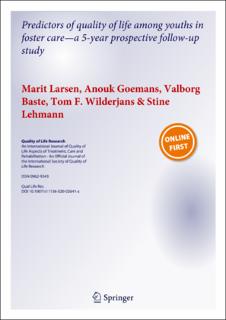| dc.contributor.author | Larsen, Marit Hjellset | |
| dc.contributor.author | Goemans, Anouk | |
| dc.contributor.author | Baste, Valborg | |
| dc.contributor.author | Lehmann, Stine | |
| dc.date.accessioned | 2021-02-19T12:28:08Z | |
| dc.date.available | 2021-02-19T12:28:08Z | |
| dc.date.created | 2020-09-29T14:29:35Z | |
| dc.date.issued | 2020 | |
| dc.identifier.issn | 0962-9343 | |
| dc.identifier.uri | https://hdl.handle.net/11250/2729239 | |
| dc.description.abstract | Purpose
Few studies have investigated possible predictors of positive outcomes for youths in foster care. The aim of this prospective follow-up study was to examine quality of life (QoL) among youths in foster care and to assess whether contextual and child factors predicted QoL.
Methods
Online questionnaires were completed by carers in Norway in 2012 (T1, n = 236, child age 6–12 years) and by youths and carers in 2017 (T2, n = 405, youth age 11–18 years). We received responses on 116 of the youths at both T1 and T2, and our final sample consisted of 525 youths with responses from T1 and/or T2. Child welfare caseworkers reported preplacement maltreatment and service use at T1. We assessed mental health and prosocial behavior at T1 by having carers complete the Strength and Difficulties Questionnaire and QoL at T2 with youth-reported KIDSCREEN-27. We analyzed the data using descriptive statistics, t-tests and multiple linear regressions, and we used multiple imputation to handle missing data.
Results
Youths in foster care had lower QoL across all dimensions compared to a Swedish general youth sample. QoL scores among our sample were similar to Norwegian youths with ill or substance abusing parents and to European norm data. Youths reported the highest QoL scores on the parent relations and autonomy dimension. Male gender, younger age, kinship care and prosocial behavior five years earlier predicted higher QoL.
Conclusion
Similar to other at-risk youths, youths in foster care seem to have lower QoL than the general Scandinavian population. Despite early adversities, they had good relations with their current carers. Adolescent girls seem especially vulnerable to low QoL and might need extra support to have good lives in foster care. | en_US |
| dc.language.iso | eng | en_US |
| dc.publisher | Springer | en_US |
| dc.rights | Navngivelse 4.0 Internasjonal | * |
| dc.rights.uri | http://creativecommons.org/licenses/by/4.0/deed.no | * |
| dc.title | Predictors of quality of life among youths in foster care—a 5‑year prospective follow‑up study | en_US |
| dc.type | Journal article | en_US |
| dc.type | Peer reviewed | en_US |
| dc.description.version | publishedVersion | en_US |
| dc.rights.holder | Copyright 2020 The Author(s). | en_US |
| cristin.ispublished | true | |
| cristin.fulltext | original | |
| cristin.qualitycode | 2 | |
| dc.identifier.doi | 10.1007/s11136-020-02641-z | |
| dc.identifier.cristin | 1834988 | |
| dc.source.journal | Quality of Life Research | en_US |
| dc.source.pagenumber | 543–554 | en_US |
| dc.identifier.citation | Quality of Life Research. 2021, 30, 543–554 | en_US |
| dc.source.volume | 30 | en_US |

